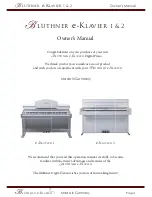
2
Do not touch the lithium-ion battery with wet hands. Doing so may result in electric shock or a
malfunction.
Use the dedicated charger to charge the lithium-ion battery. If charging conditions or a charger
different from that specified is used for charging, the battery may leak, overheat, or catch fire.
Always hold the plug itself when disconnecting the cable from an outlet. Pulling on the cable may
damage it and cause a fire or electric shock.
Do not use, charge, or store the lithium-ion battery in a high-temperature environment. Doing so
may cause the batteries to overheat, catch fire, or rupture.
Do not throw or submit the lithium-ion battery to strong impacts such as from a fall from a high
location. If the lithium-ion battery is deformed or if the built-in protection system is broken, an
abnormal current or voltage may be applied to the battery during charging, which may cause the
batteries to overheat, rupture, or catch fire.
Do not step on the lithium-ion battery or pierce with a nail or hit with a hammer. If the lithium-ion
battery is deformed or if the protection system is damaged, the battery may overheat, rupture, or
catch fire.
Should an unusual odor, heat, discoloration, deformation, or other previously unnoticed
abnormality occur during use, charging, or storage, remove the lithium-ion battery from the
instrument or charger and discontinue use. Continued use of a lithium-ion battery in this condition
may cause the lithium-ion batteries to overheat, rupture, or catch fire.
If the lithium-ion battery is found to be leaking or emitting an unusual odor, keep the battery away
from any open flames. The electrolytic solution from the battery may catch fire, causing rupture or
fire.
Do not look directly at the lamp. The lamp is extremely bright and emits ultraviolet rays. Looking
directly at the light may injure the eyes.
CAUTION
(Failure to adhere to the following points may result in injury or damage to the
instrument or other property.)
When using the AC adapter, make sure, that an AC outlet is located near the instrument, and that
the AC adapter plug can be connected to and disconnected from the AC outlet easily.
When cleaning the instrument, unplug the AC adapter plug from the outlet. Failure to do so may
result in electric shock.
Do not use any lithium-ion battery other than that specified for use with the instrument. When
inserting a lithium-ion battery into the instrument, be sure to insert the battery correctly. Fire,
injury, or stains on surroundings may occur if the lithium-ion battery is damaged or leaking.
Do not use a wet lithium-ion battery.
Doing so may cause the lithium-ion battery to rupture or overheat, which could result in fire or
injury.
Do not place the instrument on an unstable or sloping surface. Doing so may result in the
instrument dropping or overturning, causing injury. Be careful not to drop the instrument when
carrying it as well.
Do not use the instrument if the sample specimen measuring port (measurement area) is in the line
of sight. Doing so may result in injury to the eye.
Take care not to pinch yourself on the areas of the instrument that open and close. Doing so may
result in injury.
Summary of Contents for CM-M6
Page 1: ...Instruction Manual Please read before using the instrument...
Page 18: ...15 Names and Functions of Parts 1 8 9 4 6 5 2 3 10 11 12 14 13 7...
Page 102: ...99...
Page 119: ...116 5 Troubleshooting Chapter 5 Troubleshooting Message List 117 Troubleshooting 119...
Page 123: ...120 6 Appendix Chapter 6 Appendix Main Specifications 121 Dimensions 122...
Page 125: ...122 6 Appendix Dimensions Unit mm 50 M6 1 0 DEPTH 6 M6 1 0 DEPTH 6 55 33 152 3 49 5 81 239...
Page 126: ...123...
Page 128: ...En 9222 A9DT 13 2016 KONICA MINOLTA INC BIFCGK...






































